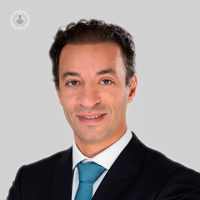What is eyelid ptosis, and who is at risk?
Written by:In this article below, expert consultant ophthalmologist, Mr Radwan Almousa, explains what eyelid ptosis is, what the causes are, as well as how it is diagnosed.

What is eyelid ptosis?
Ptosis is the drooping of the upper eyelids, and when it is severe, it might start to obstruct the upper visual field.
What causes eyelid ptosis?
In most cases, ptosis is an acquired condition which affects middle-aged or elderly patients. The main risk factor is age, and usually results from the levator muscle (the muscle that holds the eye open) becoming detached from the platform of the upper eyelid. This type of ptosis is called involutional ptosis.
Patients who use contact lenses might experience ptosis at a younger age, as the contact lens typically rubs on the back of the levator muscle, and, as a result, might cause it to detach from the tarsus.
Ptosis can also occasionally appear from birth, and this type is related to the fact that the levator muscle is replaced with fibrous tissue. Less frequently, ptosis could also be related to levator muscle or nerve damage.
Who is at risk of eyelid ptosis?
As we mentioned earlier, ageing is a risk factor for ptosis. Another risk factor is wearing contact lenses.
Is eyelid ptosis serious?
The main problem of ptosis is the constriction of superior visual field. There is one condition associated with ptosis, associated with sharp headaches, that requires medical attention. In this case, brain imaging is warranted to check for brain dilated blood vessels (aneurysm).
How is eyelid ptosis diagnosed?
Usually, patients notice the droopy eyelids themselves, and the main complaint is the difficulty maintaining the eyelids open when reading. Ptosis can also be identified incidentally by the optician or the doctor.
Does eyelid ptosis go away on its own? How is it treated?
Unfortunately, when ptosis occurs, it is there to stay. The main treatment is surgery to re-attach the levator muscle back to the tarsus. The surgery can be performed from the skin side or from the inside of the eyelid, depending on the case.
Book an appointment today with Mr Radwan Almousa by visiting his Top Doctors profile.


